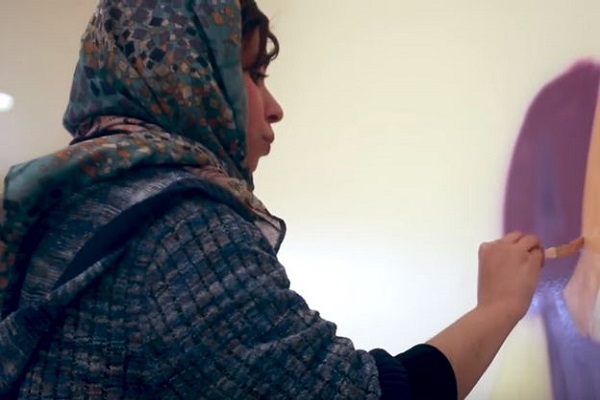
Breakthrough Female Muslim Street Artist Challenges War and Stereotypes
- By Elisa Meyer --
- 22 Feb 2016 --

Street Artist Shamsia Hassani: “I want to cover all bad memories of war from people’s minds with colors.”
Shamsia Hassani has beaten all the odds, and she has stood up ready to change the history of Afghanistan. She is the first prominent woman who has done exceptional work in street art. But who is Shamsia Hassani in the first place?
Hassani was born in the year 1988 in Tehran to Afghan parents, but she eventually moved to Kabul where she pursued her bachelor’s degree and later a master’s degree in visual art. It is through her career path that she has identified an opportunity for spreading a message of peace and hope to her mother country and the community as a whole.
Breakthrough Female Muslim Street Artist Challenges War and Stereotypes[/tweetthis]
For many years, Afghanistan has been viewed as a country filled with unending war and violence. This has been the driving force behind Hassani’s quest to change this story through visual arts. In an interview with Street Art Bio, Hassani said: "I want to cover all bad memories of war from people’s minds with colors.”
"I want to change the shape of women. I am painting them larger than life" – Shamsia Hassani ? pic.twitter.com/48ljN3bZE6
— a princess (@wajihahaha) February 22, 2016
As a woman, she has also strived in her artwork to show the strength of a woman and the roles they play in the society. "In my artwork, there is lots of movement. I want to show that women have returned to Afghan society with a new, stronger shape. It’s not the woman who stays at home. It’s a new woman. A woman who is full of energy, who wants to start again. You can see that in my artwork, I want to change the shape of women. I am painting them larger than life. I want to say that people look at them differently now," she told Art Radar Journal.
Her art subjects mostly embrace the use of Islamic burqa and hijab garments in passing the message which according to her, they can still be used to achieve liberty. She still believes that freedom can be reached within a traditional system.
"There are a lot of people around the world who think that the burqa is the problem," Hassani said. "They think that if women remove the burqa, then they have no problems. But this is not true. I feel that there are lots of problems in Afghanistan for women. For example, when women cannot have access to education; this is more of a problem than wearing a burqa."
"I want to change the shape of women. I am painting them larger than life" – Shamsia Hassani ? pic.twitter.com/48ljN3bZE6
— ⚡️ (@wajihahaha) February 22, 2016
Shamsia Hassani/buff.ly/1mqc8c7 paints over a photo of Darulaman Palace to show how she'd like it to look. pic.twitter.com/FI0JwjXd2n
— CatherineWynne-Paton (@wynnepaton) September 20, 2014
Hassani’s journey of visual arts has, however, encountered a lot of challenges. Being a woman, she has always faced rejection from a big number of people who still hold that women should not be allowed to work according to the Islamic norms. It is through this challenge that saw her develop her Dream of Graffiti practice where she makes digital images in the studio rather than on the street to counter sexist beliefs.
Today, Hassani, whose name means the Sun teaches graffiti at the University of Kabul.
Shamsia Hassani makes dope art – https://t.co/xPT7CQRm5W pic.twitter.com/6hsdVFtA1x
— Hampton Stall هامبتن (@HamptonStall) February 20, 2016
Hassani is currently an artist-in-residence at the Hammer Museum in Los Angeles.
"I want to colour over the bad memories of war." –our artist-in-residence Shamsia Hassani https://t.co/l51nTLiX1u pic.twitter.com/qOdZkWKFQd
— Hammer Museum (@hammer_museum) February 3, 2016



















